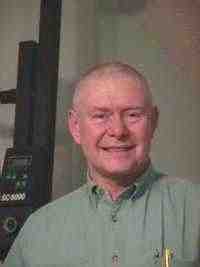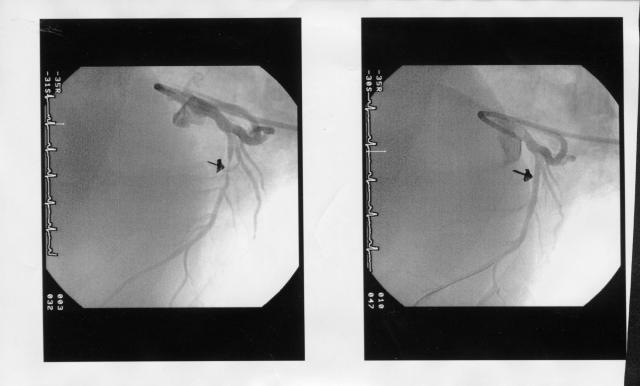
The Fit Kick
By Bill
Whedon
In mid-July, 1999, I was in the middle of changing jobs. During this process, I noticed that I was getting short of breath, and having some pain in my chest. Since my family has a history of minor asthma, I thought that might be the problem. I bought an inhaler, and treated with it for about a month. Whenever the pain would show up, I'd stop what I was doing and use the inhaler. It didn't really seem to fix anything, but I was too busy. The fact that I didn't pay attention to, and put out of my mind, even, was that my family also has a history of CHD - Congestive Heart Disease. Both sides of my family. But that couldn't possibly apply to me! I'm an aerobics instructor, after all, and very fit in the cardiopulmonary department!
By September, the pain was getting serious, and I had to consider the possibility that it may be something other than asthma. But also, about the same time, one of my daughters was seriously injured in an auto accident, and required immediate attention. The pain would have to wait. I got on the Internet, and gathered every bit of information I could, about CHD, and angina pectoris (Latin for "chest pain"), in particular. I found numerous studies on the subject, some of which suggested treatments which might work for me. I tried all of them that were possible to try with OTC (Over The Counter) medications. That ate up another month or two, and none of them worked for me. The pain had become a very frequent visitor. Any time I would change postures after a resting period of about an hour, I would have an attack. The severity was various, but usually about like this: Think about what it feels like to hit yourself in the thumb with a hammer - not quite hard enough to damage the thumbnail. Now move that pain into your chest, about 3 inches behind the sternum. Cause it to radiate outward, into your triceps, causing a "burning" pain, about equivalent to what you get when you do 50 triceps kickbacks with a fairly heavy weight. That fairly describes what I was feeling.
By mid-October, my daughter's condition was improved enough that we could bring her to our home for care, but she was still wheelchair-bound, and required a lot of time and attention. Her physicians were still in her home city, about 500 miles away, and she had to be transported there almost weekly. Not a good time for me to go into hospital, so I decided to tough it out until she was at least on crutches. The pain got worse, and the attacks more frequent. I researched some more, and decided on using a vasodilator to lessen the severity, and decrease the duration of the attacks. Since I couldn't get nitroglycerine tabs without prescription, I settled on niacin (vitamin B3), which actually did work, though slowly, to ease the pain.
One interesting sidelight of all this, is that I was still teaching aerobics. I would almost invariably have an angina attack sometime within the first 8 to 12 minutes of a class, so I simply took a niacin cap before the class, and worked through the pain. When the attack subsided, I found that I was able to continue the class at full intensity, with no further problems. The explanation for that, comes later.
Finally, in the first week of January, my daughter began walking again, and I immediately made an appointment with a Cardiologist, Dr. Gerry Love. By this time, I was having 4 to 6 attacks per day, and it was most uncomfortable and inconvenient. I had also stopped teaching aerobics, because the pain was hanging on too long, and was intense enough that I couldn't ignore it.
The visit to Dr. Love was enlightening. First, he chewed me out soundly, for ignoring the pain. I was in a position to know better, he told me. He also told me that I was a "heart attack waiting to happen". I explained what I had been experiencing, and how I had been treating it. Although still upset with me for letting it go so long, he ventured an explanation for my ability to continue to teach aerobics, without (obviously) having died yet. The constriction in the artery, whichever it was (based on the symptoms, I guessed that it was the left anterior descending coronary artery, later proved correct), had been forming for quite a long time. The plaque buildup which causes the constriction, and angina, doesn't happen overnight. However, about the same time that plaque started forming, I had begun a pretty vigorous exercise program, which, in order to sustain, the heart had to find other sources of blood - "collateral circulation" pathways. Of course, the extra load on the heart also caused some enlargement. Anyhow, it was that collateral circulation that made it possible for me to continue teaching my classes as long as I did. Had I not had that effect, brought about by earlier cardio exercise, I'd have probably been dead.
Anyhow, we scheduled an angiogram for the following Tuesday (the office visit was a Wednesday). I went into hospital, and got a tube and some dye shot into my coronary arteries, and directly into my heart, via the right femoral artery, starting in the groin area. I was conscious, and watched the process. The pictures taken, showed a blockage near the origin of, would you believe, the left anterior descending coronary artery! The angle of the original pictures was such that you couldn't actually see exactly whether the blockage was at the origin, or a bit away from it. A blockage at the origin, would have probably called for a bypass operation. Even so, that artery is the one single artery which it's presently possible to bypass using arthroscopic techniques, rather than the usual procedure of sawing the sternum in two -- a fact which made me feel much better!
The dye process also showed that the heart's volume was about 10% diminished - a situation which is probably repairable over time, with exercise.
To make a long story short, they moved me to another hospital for the
angioplasty, which is a procedure whereby a small balloon is inserted into
the artery, and inflated at the site of the blockage. The balloon
is shrouded in a "stent", which is a stainless-steel mesh tube which expands
and locks into place, holding the artery open once the balloon is removed.
Just prior to the 'plasty, they took another picture of the artery, which
showed that a bypass was not necessary, and another right after the balloon
had opened it up, and the stent was in place. They are here...

The arrows clearly show the blockage (about 90%, left picture), and how much the vessel opened up after the 'plasty. If you look at the arteries directly above the l.a.d.c, you can see that they are very much distended due to the pressure. In fact, prior to the procedure, my BP was 180/117 - quite dangerously high! Following the procedure, it's come back down to 130/70 which is even a bit low for my age!
The plaque formation shown here is not the result of poor eating habits, or lack of exercise. It is an hereditary thing, and all of my physicians told me that there was not one single thing I could have done, diet- or exercise-wise, to prevent it. Given my family history (my Dad, one youuger brother, one grandfather, and two of my uncles died of heart problems), I am inclined to accept their explanation for the formation. I do, however, believe the jury's still out on whether it's a preventable situation. Right now, for example, I'm taking a course of Omega-3 fatty acids, garlic tabs, and Co-Enzyme Q10, all with my Cardiologist's knowledge and consent. It remains to be seen whether that will work to prevent further, similar incidents. but it is, at worst, inexpensive and harmless. None of the stuff I'm taking has any side-effects, whatsoever.
The surmise is that, had I not quit smoking when I did (1985, at the age of 42), and started significant aerobic exercise when I did (1991), there is a large probablilty that I wouldn't have been alive to see the Doctor in the first place.
Epilogue:
Two weeks after the surgery I got a note from the Cardiologist which
stated that it was okay for me to begin teaching my aerobics classes, again.
I want to take this opportunity to thank Doctors Love, Bissing, and Tadros,
for the wonderful job they did of diagnosis and repair. I also want
to recognize the staffs of Liberty Hospital, in Liberty, MO (where the
original angiogram was taken), and of Saint Luke's Hospital, in Kansas
City, MO (where the angioplasty was performed). Those people are
dedicated, friendly, helpful, and above all, highly skilled and caring.
I am alive, well, happy, and ready to kick some aerobic butt, thanks largely
to the efforts of those fine people!
A bit of humor:
On my last day in St. Luke's, I was allowed to get up and begin walking
around at about 9:30 AM. In order to make me mobile, they removed
the EKG leads to the room monitoring equipment, and hooked me up to a radio-remote
monitor, which they hung round my neck in a sort of plastic bib-looking
bag. One of the first places I walked to, was the nurses' station,
where the video monitors keeping track of those devices, were. I
found my name, Whedon, and looked above it ... at a flat line! I
called the nurse over, and said the first thing that came into my head
- "Look. I seem to have gone flatline. If that means I've died,
I want you to know that this is a pretty crummy Heaven!" She looked
me right in the eye, and said, "And what makes you think it's Heaven you
went to!?"
People, it's good to be back!
Bill Whedon
This
article was previously published at the World Fitness Organization website:
http://www.worldfitness.org/
Free
fitness information and counselling. Fitness Trainer certification programs